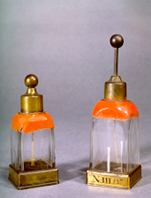
16.3 x 5.1
Glass and bronze
INDEX 1824 : N.III.157
Uno electrometro de Henly.
One Henley electrometer.
The first attempts to build instruments for measuring electrical charges, called electroscopes, were the work of Darcy and Le Roy. In 1752, Nollet invented a system consisting of two wires, suspended from the same point, which formed a determined angle between them on being electrically charged. Tibério Cavallo perfected a system in which the ends of the wires held balls made from elder pith. This was all enclosed inside a glass receptacle, with a metal rod ending in a small sphere crossing the upper part. Later, Volta constructed an electrometer that used two small rectilinear split canes, suspended from the same point by means of a highly mobile joint. The gold leaf electroscope was devised later.
The two small electroscopes presented here comprise a glass jar with a square base of brass. Two tin strips are fixed to opposite walls of the jar and join to the base, extending about half-way up. It is by means of these strips, connected to the ground by the metal base of the jar, that the electrical discharge from the glass is obtained, in the event of the suspended canes touch them when electrically charged.
One of the sides of one jar has a scale which permits the reading of the angle formed between the two split canes.
Sigaud de la Fond, Joseph-Aignan, Description et Usage d'un Cabinet de Physique Expérimentale, Paris, 1775, Vol. II, Pl. XXI.